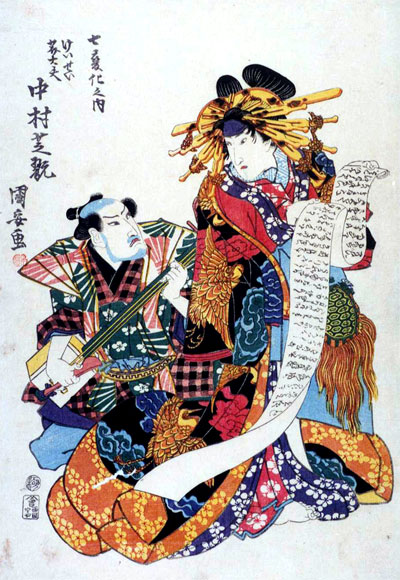| KEISEI |
| Dance title | Keisei Koi Keisei Shikan Keisei Nijirigaki Nanatsu Iroha |
| Authors | Segawa Jokô II (lyrics) Kineya Saburôsuke IV (music) |
| History |
The actor Nakamura Shikan II performed in the 3rd lunar month of 1828 at the Nakamuraza a 7-role hengemono, which was entitled "Nijirigaki Nanatsu Iroha". One of these seven roles, a keisei survived* and became the independent dance "Keisei". As it was performed by Nakamura Shikan II, it is also sometimes staged under the title "Shikan Keisei". Because of a famous line in the lyrics, it is also nicknamed "Koi Keisei" (koi meaning love in Japanese). (*) Another role has survived: "Tomo Yakko". |
| Key words | Ageya Keisei Keiseimono Kudoki Kuruwa Nagauta Shosagoto Yoshiwara |
| Summary |
The word keisei is old and is referring to a beautiful and accomplished kuruwa courtesan. The word keisei means literally "to tilt a castle", implying that a lordship may be lost for the love of a beautiful courtesan. The keisei is a favourite character in Kabuki and there are consequently many dances and dramas in which she is the central figure. The dance "Keisei" is about grace and beauty. A courtesan has been dozing in her room. She awakes and starts to dance gracefully, depicting the elegance of the courtesans and the art of love in the Yoshiwara pleasure quarter of Edo. This dance is a long and beautiful kudoki expressing the languid melancholy of the life of a keisei in a luxurious ageya. |
 |
|
The actor Nakamura Shikan II performing the role of a keisei in the hengemono "Nijirigaki Nanatsu Iroha", which was staged in the 3rd lunar month of 1828 at the Nakamuraza (print made by Utagawa Kuniyasu I) |
|
|
| Contact | Main | Top | Updates | Actors | Plays | Playwrights | Programs | Links | FAQ | Glossary | Chronology | Illustrations | Prints | Characters | Derivatives | Theaters | Coming soon | News |